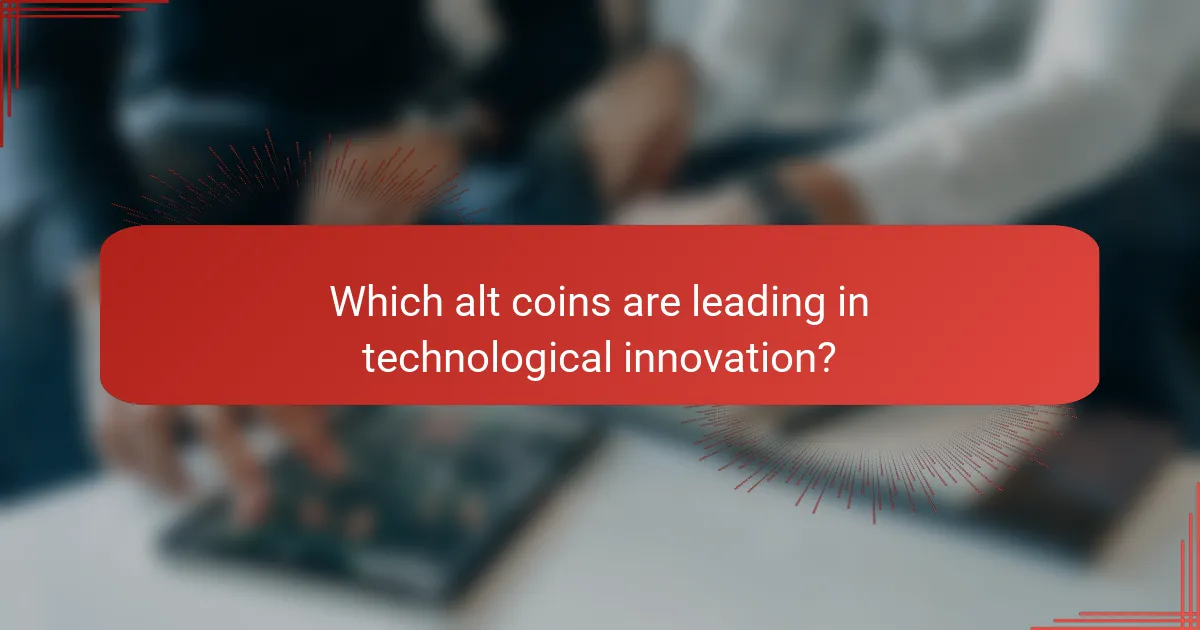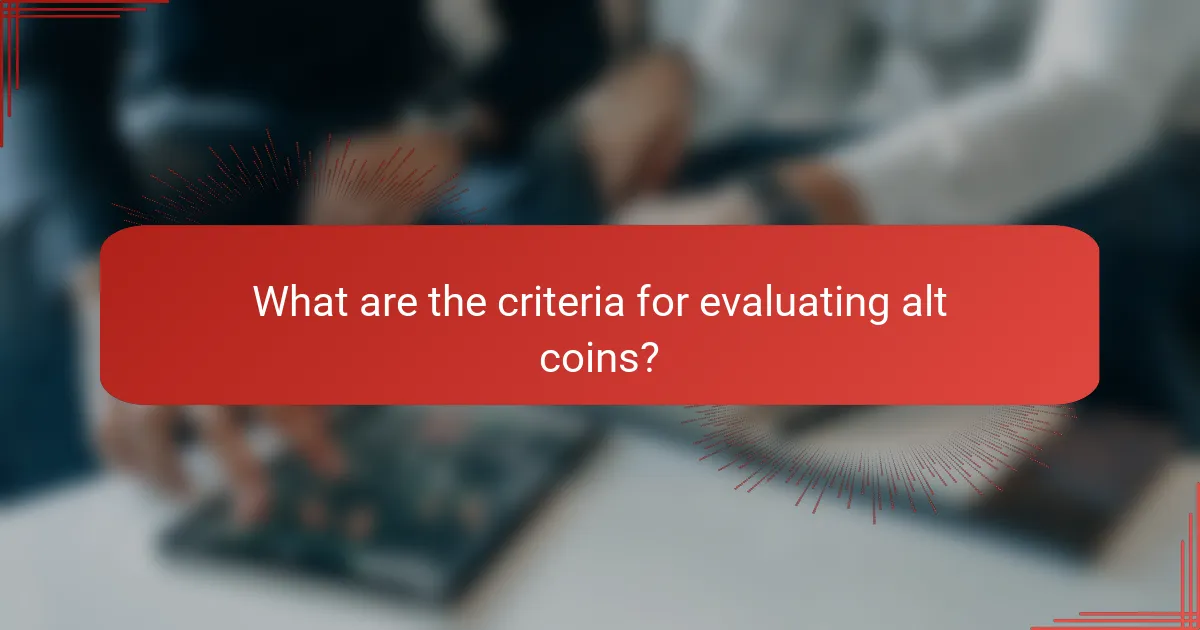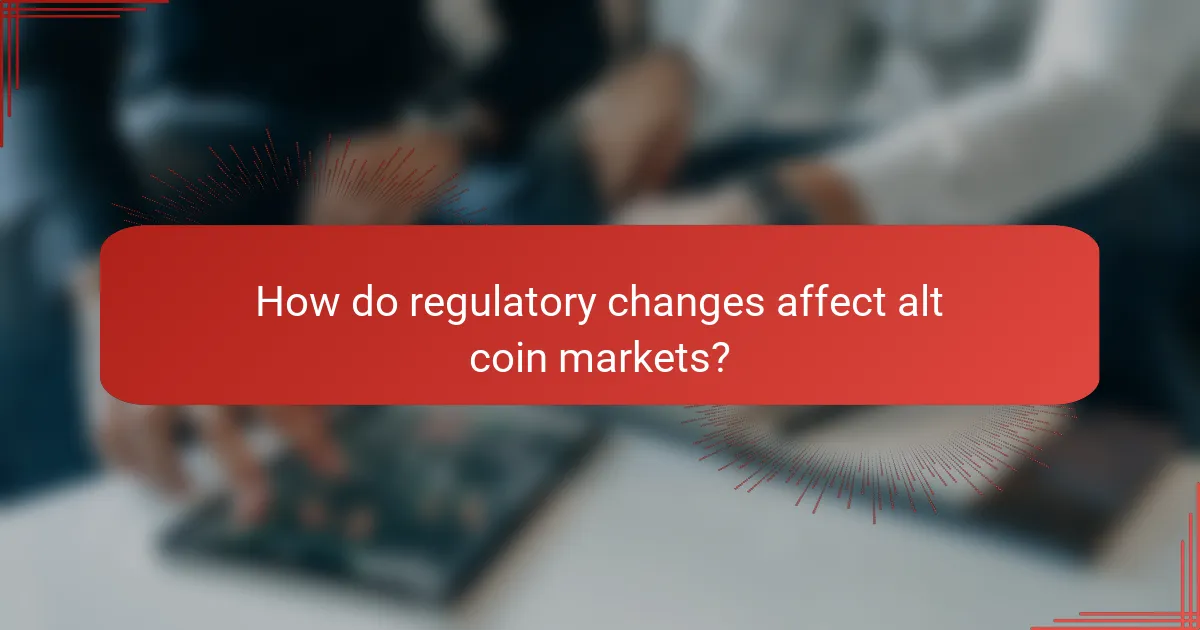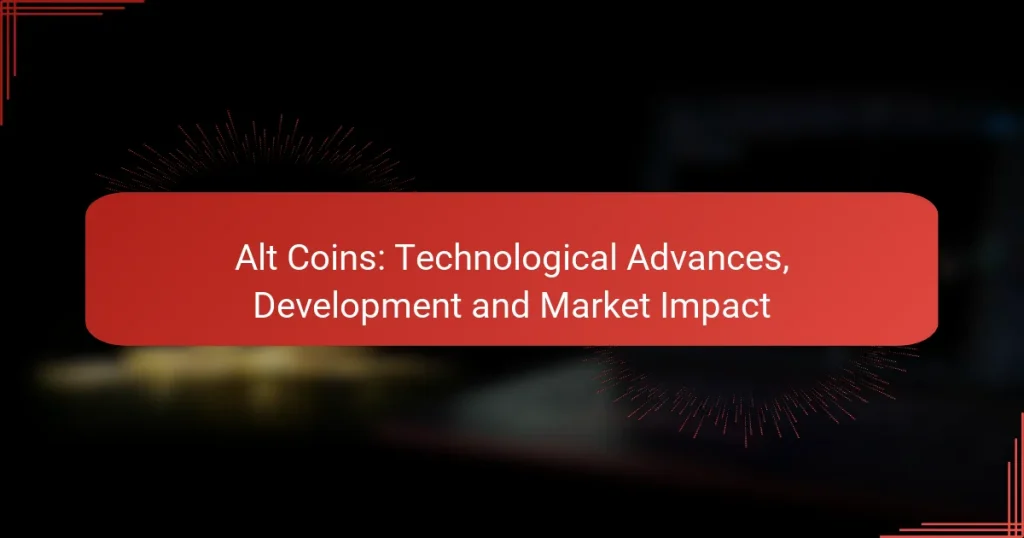Alt coins play a crucial role in the cryptocurrency landscape by introducing technological innovations and expanding investment avenues. With advancements like smart contracts and interoperability protocols, these digital assets are reshaping market dynamics and enhancing user experiences. Leading platforms such as Ethereum, Cardano, and Solana exemplify the potential of altcoins to drive both development and market growth.

How are alt coins impacting the cryptocurrency market?
Alt coins significantly influence the cryptocurrency market by diversifying investment opportunities and driving innovation. Their emergence has led to increased market capitalization and trading activity, reshaping how investors approach digital assets.
Market capitalization growth
The introduction of alt coins has contributed to substantial growth in the overall market capitalization of cryptocurrencies. While Bitcoin remains the dominant player, alt coins collectively represent a significant portion of the market, often accounting for over 40% of total capitalization.
Investors are increasingly allocating funds to alt coins, which can lead to rapid price increases and market fluctuations. This growth can be attributed to the introduction of unique features and use cases that appeal to different segments of the market.
Diversification of investment options
Alt coins provide investors with a broader range of investment options beyond Bitcoin. With thousands of alt coins available, investors can choose from various projects that focus on different technologies, such as smart contracts, decentralized finance (DeFi), and non-fungible tokens (NFTs).
This diversification allows investors to tailor their portfolios according to risk tolerance and investment goals. However, it is crucial to conduct thorough research on each alt coin, as the volatility and potential for loss can be significant.
Increased trading volume
The rise of alt coins has led to increased trading volume across cryptocurrency exchanges. As more investors engage with alt coins, trading platforms experience higher activity levels, which can enhance liquidity and reduce spreads.
Increased trading volume can also attract institutional investors looking for opportunities in the alt coin space. However, traders should be aware of the potential for price manipulation and ensure they use reputable exchanges to mitigate risks.

What technological advances are driving alt coin development?
Technological advances such as smart contract functionality, layer 2 scaling solutions, and interoperability protocols are significantly influencing the development of altcoins. These innovations enhance transaction efficiency, reduce costs, and improve the overall user experience in the cryptocurrency market.
Smart contract functionality
Smart contracts are self-executing contracts with the terms of the agreement directly written into code. They automate processes and reduce the need for intermediaries, which can lower transaction costs and increase speed. For instance, platforms like Ethereum utilize smart contracts to facilitate decentralized applications (dApps) that operate without central control.
When considering smart contracts, it’s essential to evaluate the underlying blockchain’s capabilities and security features. Bugs in the code can lead to vulnerabilities, so thorough testing and audits are crucial before deployment.
Layer 2 scaling solutions
Layer 2 scaling solutions aim to improve transaction throughput and reduce fees on primary blockchains. These solutions, such as the Lightning Network for Bitcoin and Optimistic Rollups for Ethereum, allow transactions to occur off the main chain, alleviating congestion and enabling faster processing times.
Users should assess the trade-offs between security and speed when using layer 2 solutions. While they can significantly enhance performance, they may introduce additional complexities and require users to understand new protocols. Always verify the compatibility of layer 2 solutions with your preferred wallets and exchanges.
Interoperability protocols
Interoperability protocols facilitate communication and data exchange between different blockchain networks. Solutions like Polkadot and Cosmos enable diverse blockchains to work together, allowing assets and information to move seamlessly across platforms. This enhances the utility of altcoins by broadening their use cases and market reach.
When exploring interoperability options, consider the potential for increased liquidity and user engagement. However, be aware of the varying levels of security and decentralization across different protocols, as these factors can impact the overall reliability of cross-chain transactions.

Which alt coins are leading in technological innovation?
Ethereum, Cardano, and Solana are at the forefront of technological innovation in the altcoin space. Each of these platforms offers unique features and capabilities that enhance their usability and market impact.
Ethereum (ETH)
Ethereum is known for its smart contract functionality, which allows developers to create decentralized applications (dApps) on its blockchain. This capability has led to a vibrant ecosystem of projects ranging from finance to gaming.
With the transition to Ethereum 2.0, the network is moving from a proof-of-work to a proof-of-stake consensus mechanism, aiming to improve scalability and reduce energy consumption. This upgrade is expected to significantly enhance transaction speeds and lower fees.
Cardano (ADA)
Cardano distinguishes itself with a research-driven approach to development, emphasizing security and sustainability. Its unique proof-of-stake protocol, Ouroboros, allows for energy-efficient transactions while maintaining a high level of security.
Cardano’s layered architecture separates the settlement layer from the computation layer, which enhances flexibility and scalability. This design enables smart contracts to be executed with greater efficiency and lower costs, appealing to developers and users alike.
Solana (SOL)
Solana is recognized for its high throughput and low transaction costs, making it an attractive option for developers looking to build fast and scalable applications. Its unique consensus mechanism, called Proof of History, allows for quick verification of transactions, achieving speeds of thousands of transactions per second.
The platform’s growing ecosystem includes decentralized finance (DeFi) projects and non-fungible tokens (NFTs), attracting significant interest and investment. However, potential users should consider the network’s relatively young infrastructure and the associated risks of rapid growth.

What are the criteria for evaluating alt coins?
Evaluating alt coins involves several key criteria that can help investors determine their potential value and viability. Important factors include market liquidity, the expertise of the development team, and the level of community support surrounding the coin.
Market liquidity
Market liquidity refers to how easily an alt coin can be bought or sold without significantly affecting its price. A liquid market typically has a high trading volume, which allows for smoother transactions and less price volatility.
When assessing liquidity, consider the average daily trading volume and the number of active exchanges where the coin is listed. Coins with low liquidity may experience larger price swings and pose higher risks for investors.
Development team expertise
The expertise of the development team is crucial for the long-term success of an alt coin. A strong team with a proven track record can enhance the project’s credibility and increase investor confidence.
Look for information about the team’s background, previous projects, and their engagement with the community. Transparent communication and regular updates can also indicate a dedicated and capable team.
Community support
Community support plays a significant role in the sustainability and growth of an alt coin. A strong, active community can drive adoption, provide valuable feedback, and contribute to the project’s development.
Evaluate community engagement through social media platforms, forums, and online groups. High levels of participation and enthusiasm can signal a healthy ecosystem that supports the coin’s future success.

How do regulatory changes affect alt coin markets?
Regulatory changes significantly impact alt coin markets by influencing trading practices and compliance requirements. As governments and financial authorities introduce new regulations, they can alter market dynamics, investor behavior, and the overall viability of various alt coins.
Impact on trading practices
Regulatory changes can lead to shifts in trading practices among investors and exchanges. For instance, stricter regulations may require exchanges to implement enhanced Know Your Customer (KYC) procedures, which can slow down the trading process and reduce market liquidity. Traders may also adjust their strategies to comply with new rules, impacting how and when they buy or sell alt coins.
Additionally, regulations can affect the availability of certain alt coins on exchanges. If a coin is deemed non-compliant, it may be delisted, limiting trading options for investors. This can lead to increased volatility as traders react to news about regulatory developments.
Compliance requirements
Compliance requirements vary significantly across jurisdictions and can impose substantial burdens on alt coin projects and exchanges. Many countries now require alt coin projects to register with regulatory bodies and adhere to anti-money laundering (AML) and counter-terrorism financing (CTF) laws. This can involve extensive documentation and ongoing reporting obligations.
For example, in the European Union, the Markets in Crypto-Assets (MiCA) regulation aims to create a unified framework for crypto assets, including alt coins. Projects operating in the EU must ensure they meet these compliance standards, which may involve legal consultations and adjustments to their business models. Non-compliance can result in hefty fines or legal action, making it crucial for alt coin projects to stay informed and proactive regarding regulatory changes.


